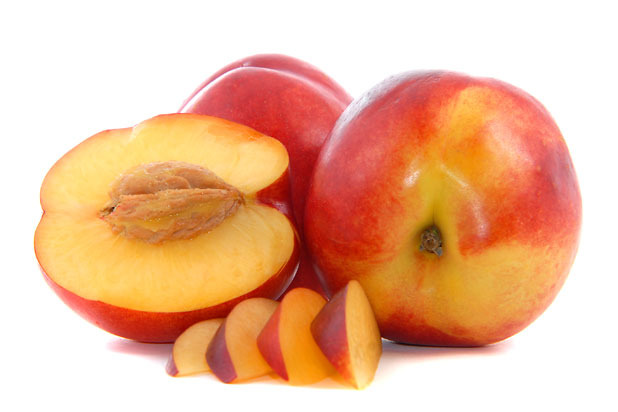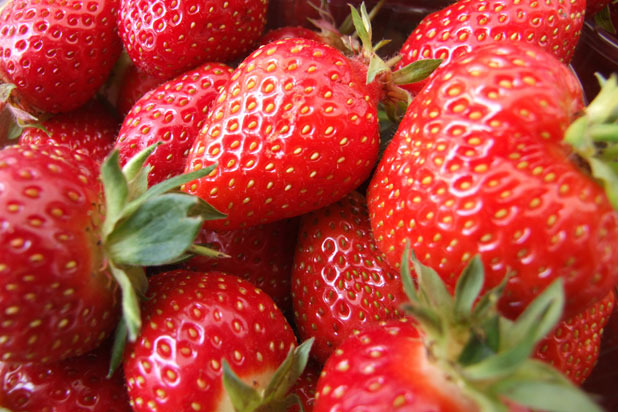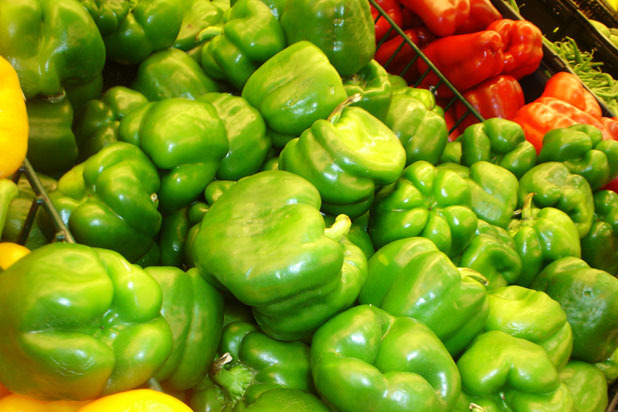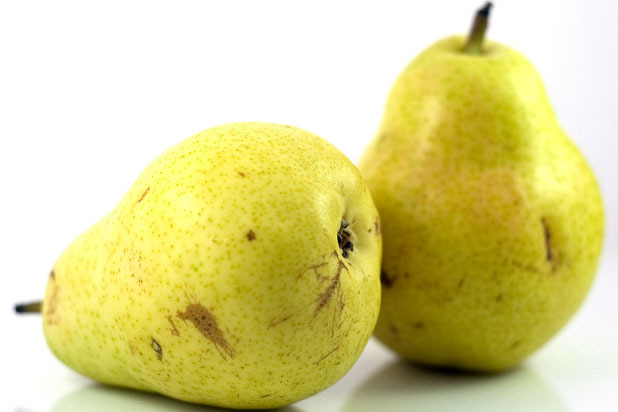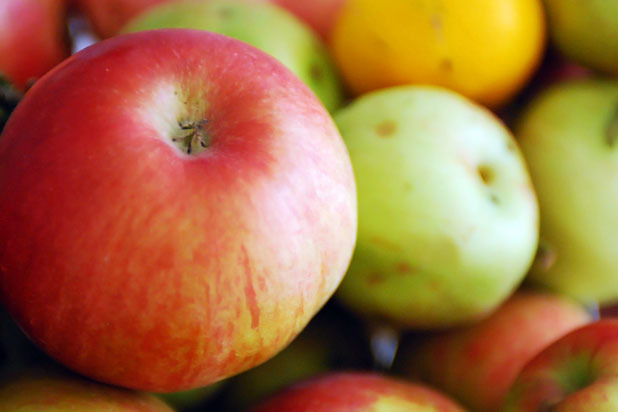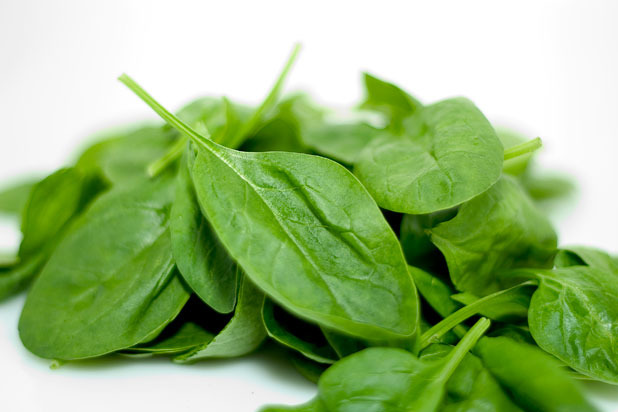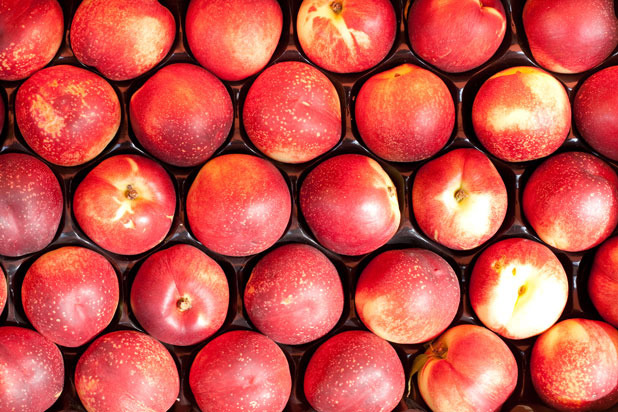10 Foods With The Highest Pesticide Residue Levels Slideshow
Telling someone they are a peach may be a compliment, but eating a peach may have some bad consequences. Peaches greatly benefit from the use of pesticides, due to their susceptibility to pests and mold, but their fuzzy skins cause them to retain the chemicals. In 2008, the U.S. Department of Agriculture found 50 pesticide compounds on both domestic and imported peaches. Though most of them were at levels far below the EPA's tolerance standards, scientists were concerned that pregnant women and children may suffer if exposed. Dietary exposure to chlorpyfiros, which is found in 17 percent of conventional peaches, has been shown to cause cognitive impairment in rats.
Alternative: Though the number of calories are hardly comparable, almonds and peaches both contain significantly similar nutrients and vitamins. Thiamine, riboflavin, niacin, and vitamin E are all present in these two members of the rose family.
2. Strawberries
This sweet summer fruit is guilty of carrying nearly 54 pesticides on average, nine of which are known carcinogens; others affect your neurological, reproductive, and hormonal functions. In California, a debate between the State Department of Pesticide Regulation and a scientific review committee erupted when a pesticide called methyl iodide was approved and used on local strawberries before being tested on animals. Unfortunately, the pesticide is known to be a neurotoxin, developmental toxin, and an endocrine disruptor.
Alternative: Look elsewhere into the berry family to get a nutritious alternative to the offensive strawberry. Though strawberries contain a high amount of vitamin C, they aren't the only fruit that offers this powerful antioxidant. Raspberries, blackberries, and kiwis have that sweet-tart taste at much lower levels of pesticide contamination and an equal amount of vitamin C.
3. Bell Peppers
There are few dishes that aren't enhanced by the sweet bell pepper, but even fewer foods that have as high a probability of carrying pesticides. Bell peppers, known to be exposed to nearly 50 pesticides, were found to carry some of the highest number of pesticides on one specimen (11, to be exact). With nearly 11 known or probable carcinogens and developmental toxins, conventional sweet bell peppers can also carry a pesticide that is toxic to honeybees.
Alternative: Aside from an abundance of vitamin C, red bell peppers contain moderate levels of carotenoids and vitamin A. While it's hard to find a substitute, making do with tasty veggies like broccoli or carrots isn't too unfavorable an alternative, both taste-wise and nutrition-wise — one can get plenty of vitamin A and carotenoids from these vegetables.
4. Pears
The buttery, sweet goodness that is the pear might not be worth the risk of exposure to some scary pesticides. Though peeling the skin may drastically reduce your chance of consuming them, there are 28 possible pesticides to ingest, such as azinphos-methyl. One pesticide to be particularly wary of is methyl parathion, one of the most toxic organophosphate pesticides. Though the EPA has banned its usage, exposure is still possible, and evidence of the pesticide is still being found. It can overstimulate the nervous system and cause nausea, dizziness, confusion, and at high exposures, respiratory paralysis and death. It is particularly dangerous for children.
Alternative: Pears are a great source of minerals such as copper, iron, and potassium, and many other vital minerals. However, they certainly aren't the only fruit that contains them. Dates, pomegranates, and even avocados contain high amounts of those same minerals.
5. Apples
Though an apple a day may keep the doctor away, it is the worst offender in pesticide residue. More than 92 percent of the apples tested contained one or two pesticides even after washing. There are possibly 48 pesticides that can contaminate the apple, with most of them resting on the skin. While some suggest peeling the skin, keep in mind that most of the apple's nutritional benefits will be peeled away as well. It is theorized that contamination is so high because pesticides are used after harvesting to give apples a longer shelf life.
Alternative: Look to the tropics for a healthy alternative. The pineapple is not only a super sweet and tasty alternative to the apple, it is one of the cleanest fruits out there. Pineapples are a great source of vitamin C as well as bromelain, which helps reduce swelling, bruising, healing time, and physical pain.
6. Celery
This crisp vegetable that goes fabulously with everything from peanut butter to cream cheese is a vessel for more than just ants on a log. Celery is actually susceptible to 64 potential pesticides, 13 of which are carcinogens and 31 of which are potential hormone disruptors. Because of its soft skin, celery is very prone to absorption of toxins.
Alternative: Though a salad and snacking staple, celery yields few benefits worth risking the residue exposure. Romaine lettuce and carrots serve as a great alternative to bits of celery.
7. Spinach
Leafy and bitterly delicious, conventional spinach might have made Popeye strong, but it could also damage your health due to residues. It often contains a pesticide called permethrin, a neurotoxin. Symptoms of high exposure include tremors, loss of coordination, elevated body temperature, and behavioral problems. The pesticide has also been labeled as a carcinogen because it causes lung tumors in female mice and liver tumors in mice of both sexes. This is in addition to the potential exposure to 48 other harmful pesticides.
Alternatives: The green leaf can easily be swapped for safer choices such as broccoli or Brussels sprouts. These reasonable substitutes are high in carotenoids, vitamins A and C, and folate, all of which are present in spinach.
8. Imported Grapes
Domestic grape eaters need not worry, but those who unknowingly pick up a bag of imported grapes will be picking up more than a snackable fruit or a foreign wine. A sample of imported grapes contained more than 14 pesticides. During the different growth periods of the grape, vineyards are often sprayed with an array of different pesticides. No amount of washing will remove pesticides, due to grapes' naturally thin skin.
Alternatives: Research shows that grapes are actually loaded with resveratrol, a nutrient that helps with healthy aging. While grapes do contain the highest amounts of resveratrol, cranberries and even peanuts are loaded with this age-defying ingredient.
9. Nectarines
The distant cousin of the peach is similar in more ways than just taste; it makes the list for one of the highest carriers of pesticides. One of the 33 potentially ingested residues is called chlorpyrifos, a dangerous substance that can cause a significant amount of defects, including toxic effects on the kidneys and livers.
Alternative: Nectarines are loaded with vitamin A, vitamin E, and flavonoid polyphenolic antioxidants. To avoid the dangers of those pesky pesticides, try feasting on the apricot. Loaded with nearly all of the same nutrients, this substitute serves as a healthy alternative.
10. Potatoes
A favorite side dish during the holidays, this starchy vegetable should also be noted for its high level of unhealthy residues. Pesticides play a significant role in the growth of a potato. Before seeds are even planted, insecticides to kill off wireworms are sprayed into the soil. To prevent the spread of blight, seeds are drenched in fungicides. Systemic insecticides that penetrate the entire plant are used when young potato plants are covered with dirt. With 37 possible pesticides, potatoes might make the list of foods to avoid (or at least buy organically).
Alternative: A similar and tasty alternative is the sweet potato, which is low in pesticide contamination and healthier overall.
